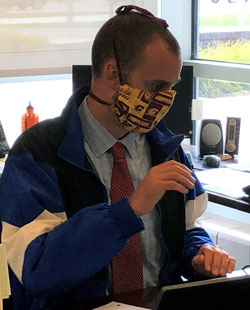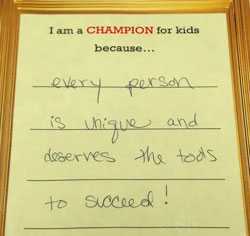Aaron Romoslawski is the new vice principal of Sparta High School. SNN gets to know him in this edition of Meet Your Administrator. He takes over for Stacey Rumsey, who was named Sparta High School principal last spring.
Education and previous positions: Romoslawski is originally from the east side of the state, but has long had ties to the Spartan community.
He grew up in Flushing, Michigan, and attended college at Central Michigan University, where he graduated in 2007 with a BS in education, majoring in social studies and minoring in history. While teaching social studies and history at LaPeer High School, near his hometown, he often promised his wife they’d someday move closer to her family in Western Michigan. Six years ago he made good on that promise and took an administrative position at Grand River Preparatory High School in Kentwood. He also holds a Master’s of Public Administration with education emphasis from U of M – Flint.

Family, community: An aunt was a teacher in the district, beginning with student teaching in kindergarten in 1978 and taught first, second, fourth and sixth grade language arts, retiring from eighth grade language arts in 2013, and a cousin was a teaching intern at the high school. “They were so excited to hear I was coming here,” said Romoslawski. “It was really just, ‘Welcome to The Ridge.’”
He said he has found the community both welcoming and inspiring. “I am super excited to be here,” he said. “It feels like joining a family, with such a great sense of community and togetherness. It is full of color.”
He also pointed to a Zoom school board meeting and commented, “There were so many people engaged. It is a great sign that it is a good and supportive community.”

An early goal: Working with high school students was a decision he made as a teenager, Romoslawski said. “I wasn’t such a stellar student back then, and I was surrounded by some folks that weren’t very supportive. I made the decision that if I were in that position, this is what I would do: strive every day to make sure teachers have what they need to support students in what they need.”
A major influence was the relationship he had with his grandparents, both of whom spent time “in the camps during World War II,” he said. “I learned so much from listening to their stories as a first-generation American.”
Up to his grandfather’s recent death, he spent time asking questions, and listening and recording their stories. “For sure, those stories provided context for me when I first started teaching social studies.”
Lessons learned from students: The power of possibility. “When you are 15-18 you think about things differently,” he said. “As educators, we have to make sure that all roads of opportunity are open while we guide them to be highly successful adults. We need to allow them to pursue a dream while developing skill sets necessary to do it.”

From the coronavirus pandemic: That all teachers stepped up. “I take pride in seeing how resilient teachers can be,” Romoslawski said.
“It is an interesting and profound time for educators. In many ways we’ve learned ‘we get to be here’ instead of ‘we have to.’ At the end of the day, all teachers are in it for the kids. We just need to constantly remind ourselves why we do it.” That philosophy led him to ask teachers to write down why they “champion” kids and put it in a place where they see it often.
One good to come: “I think we are finding education to be more dynamic and responsive to community and family needs than we were able to in the past. We have been able to do things we couldn’t before, and it will be interesting to see if the legislature allows us to continue doing some of these innovative things and unique offerings in the future.”
One example is shorter in-person days, which allow teachers to offer more concentrated lessons that lend themselves to deeper discussions when teachers and students are together, he said. “It has been exciting to see how teachers have been doing things in different ways, but only time will tell if we have the framework to let us continue with these innovative ways of teaching.”









